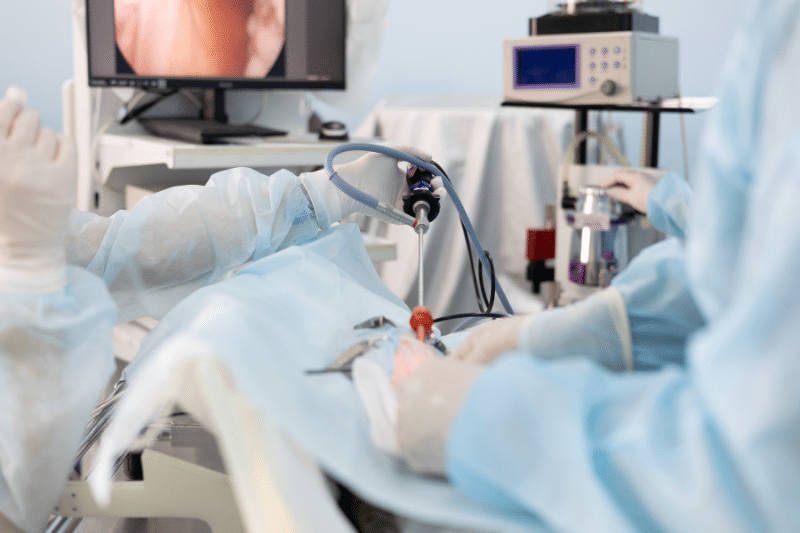Endoscopic Sleeve Gastroplasty FAQs - Pre-Operative
Find answers to Endoscopic Sleeve Gastroplasty FAQs. Explore procedure benefits, cost, and insurance coverage. Particularly, what to expect before and after the procedure.
What is Endoscopic Sleeve Gastroplasty (ESG)?
Endoscopic Sleeve Gastroplasty or ESG is a non-surgical technique. Furthermore, it does not use incisions. But reduces the size of the stomach by approximately 70% through the use of sutures.
The entire procedure performed through an endoscope. Moreover, it lowered down the patient’s throat. An endoscope is a flexible hollow tube that has a camera mounted at the end. Then, the surgeon can see exactly what they are doing in real-time. As the image projected onto a video monitor.
During ESG, a special medical device (OverStitch suturing tool) lowered down through the endoscope. To reshape the stomach into a small pouch and secure it. ESG produces similar results to that of a surgical sleeve gastrectomy

How is ESG Different than a Surgical Sleeve Gastrectomy or Vertical Sleeve (VSG)?
In particular, this is one of the important Endoscopic Sleeve Gastroplasty FAQs. The main difference is that ESG is non-surgical and does not involve the use of incisions. Even so, the whole procedure performed endoscopically through the mouth.
Evidently, ESG reduces the size of the stomach like a Surgical Sleeve Gastrectomy (VSG). But unlike a surgical sleeve, no portion removed from the stomach. Unquestionably, endoscopy procedures offer faster healing and recovery. Besides that lowers complication risks, and allows patients to return to normal life quicker. In addition to this, the procedure does not require a hospital stay and patients can go home the same day.
Who is the Candidate for ESG?
Individuals with heavier body weight or who have a BMI of over 30. Additionally, have not been able to lose weight through diet and exercise are candidates for ESG. At times, ESG helps a patient lose an initial amount of weight. Because they are in poor health. Therefore, the surgery is not presently an option for them.
Who is Not the Candidate for ESG?
However, individuals who have known stomach problems. Such as ulcers, a very large hernia, bleeding disorders, or other major health problems. Eventually, they may not be good candidates for ESG.
How Long Does an Endoscopic Sleeve Gastroplasty Take?
In reality, the procedure normally takes under 45 minutes. Then the medical staff observes the patient. In a recovery room setting for a few hours before discharging them home.
Endoscopic Sleeve Gastroplasty FAQs - Post-Operative
When Can I Go Back to Work After ESG?
Similarly, most patients take off at least 3 days after having ESG. Further to rest and become acclimated to their new stomach size. Although, if the patient has a physically demanding job. Then the surgeon will monitor their recovery and advise them when to return to work.
How Much Weight Can I Lose With ESG?
Undeniably, patient weight loss results will vary. Especially based on their starting weight, motivation, commitment level, and adherence to their dietary plan. In the same manner, results can be anywhere between 25% of excess body weight. Finally 70% of excess weight loss during a 6-18 month period.
Can the Sutures Come Loose?
Very rarely do ESG sutures fail. Only 1% cases reported. In any event, if needed additional sutures, it can add to repair any issues.
How Many Stitches Do Doctors Use in the Stomach?
Normally, the surgeon uses anywhere between 5 and 12 sutures. Alongside the curve of the stomach to hold the new shape in place. However, the final number of sutures placed will vary depending on the shape and size of the patient’s stomach.
Do the Stitches Dissolve?
During the ESG procedure, doctors use sutures made from strong, durable prolene. Consequently, do not dissolve, considered permanent unless removed by a surgeon.
What Happens to the Stitches as the Stomach Heals?
These sutures will continue to hold the stomach in the new “sleeve-like” shape. Until it fully heals and then they will remain where they are. Regardless, the stomach will stiffen and should remain in that smaller shape for the long term. If the patient continues to follow dietary protocol. In the final analysis, the stitches themselves do not pose any long-term risk.
Can X-rays or MRIs Show the Stitches?
Each stitch does have a tiny metal cap on the end. They are only visible by x-ray and have a tiny, metallic anchor at their end. They won’t affect during an MRI. Thus, do not worry about setting off any metal detectors.
What are the Most Common Side Effects After ESG?
Firstly, the side effects are short-term, and usually mild and treatable by over-the-counter pain relievers and medication used for anti-nausea. Secondly, patients also may experience fatigue for about two weeks as a result of the lower intake of calories.
Is There a Risk of Serious Side Effects With the Procedure?
Risks that are related to the EGS procedure are far lower than those associated with a surgical weight loss procedure. But any procedure always carries associated risks. With ESG, it’s 0.5-1%, in rare cases may include infection, bleeding, or stomach injury.
What Will it Feel Like After the Procedure?
Certainly, all patients will feel what we refer to as “restriction” or a feeling of being full. Think about when you have overeaten. And how you can feel somewhere between mildly uncomfortable to miserable. It is similar to that and will vary for each patient.
With that said, the restriction felt directly after the procedure will ease off a bit. Later, as the stomach heals and adjusts to its new size. Usually, patients have to ease back into eating solid foods.
Later, patients begin with liquids (very small amounts) at first. Gradually, move on to soft foods, and work their way back up to solids. It is important to eat slowly to give your body time to register that you are full. Lastly, a recommended diet will be provided to you to ensure you consume a balanced diet.
Are There Any Complications After the Part of the Stomach Stitched Up?
The part of the stomach that undergoes suturing during ESG is “the greater curve”. The procedure makes this area thicker. The blood supply to that area of the stomach remains unaltered. Though, no long-term risks reported with suturing the stomach.
Does ESG Reduce the Level of Ghrelin Hormone Released?
Ghrelin is a natural hormone. The stomach produces and releases those annoying hunger pangs into the body. Gastric sleeve surgery removes a large portion of the stomach. Without a doubt, it reduces the production of ghrelin initially. But also studies show it returns to normal levels after several months.
On one hand, ESG does not physically remove any of the stomachs. Because the stomach undergoes a significant size reduction. Whereas, it will take significantly less food to “turn off” the release of ghrelin into the system.
Can I Exercise or Lift Weights After Having ESG?
While there are no “formal” exercises or lifting restrictions immediately after having the ESG procedure. However, we recommend that you wait until you can consistently consume enough protein and fluids. To finally support any form of strenuous exercise.
We recommend that after having ESG, you start with light walking. That will help hasten recovery and work up to more demanding exercising. Typically most ESG patients take 3 to 4 weeks to acclimate to their new stomach size. Additionally, have enough energy to be able to engage in an intense exercise program.
Is it Safe to Get Pregnant After ESG?
Indeed, it is safe to get pregnant after having ESG. In fact, losing weight may improve the patient’s fertility due to the metabolic changes that occur with weight loss.
During your initial consultation before your ESG procedure. You should make your doctor aware that you wish to become pregnant in the future. So they can monitor and make recommendations based on your particular case accordingly.
Generally, we advise patients to allow their bodies time to heal. Adjust to the smaller stomach size before becoming pregnant. Normally this is between 12 and 18 months but could vary by patient.
What if Can't Lose Enough Weight or Hit a Plateau After ESG?
We won’t leave you on your own to navigate through your weight loss journey. Nonetheless, IBI Healthcare will be monitoring your progress. Eventually, supporting you every step of the way responding or making changes to help you be successful.
During the first 12 months after ESG, it is common to have slower periods of weight loss. Even if adhering closely to the diet and exercise program. Finally, the doctor may recommend nutritional changes or a weight loss medication. Finally, we can make certain adjustments to help keep your weight loss on track in some cases.
Can You Have ESG More Than Once?
Yes, you can undergo the ESG procedure more than once. It’s a repeated procedure to repair or tighten an existing ESG procedure.
If ESG Does Not Work For Me, Can I Have Bariatric Surgery?
Yes, in most instances, the ESG procedure safely converted to bariatric surgery.






